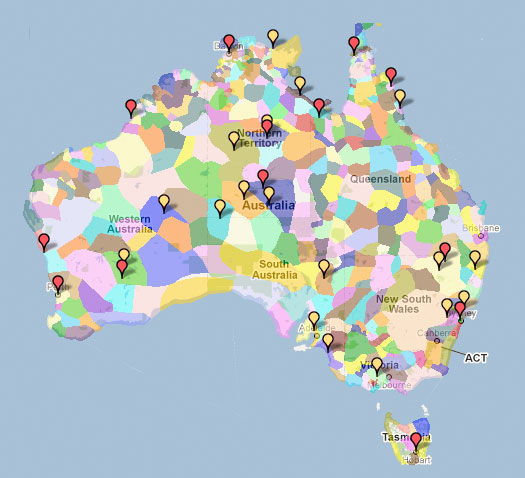
Aboriginal language map. More details available from http://www.abc.net.au/indigenous/map/default.htm. Note that is just one representation of other map sources that are available for describing Aboriginal Australia. This map indicates only the general location of larger groupings of people which may include smaller groups such as clans, dialects or individual languages in a group. Boundaries are not intended to be exact.
Now that I’ve been in Indonesia for a while one of the things my Indonesian friends often want to ask about is what happened with indigenous Aboriginal Australians after us whitefellas came to the country. Usually, the Indonesians seem to be a bit apologetic about the question. As if they know there is going to be something ugly about the answer. And I’ll feel embarrassed, ashamed, or, as Indonesians say malu about it. Well, the answer is ugly. And I do feel malu.
Vast numbers of Aboriginal people died, either because they were outright killed by the settlers or because they succumbed to diseases they had no immunity to. People were dispossessed of their lands. Children were taken from their parents and put into institutions so that they would be better assimilated into the white system. At the time of first European contact, there were around 300 languages spoken across the continent. Over 250 of these have disappeared completely and most of the rest are only spoken by a handful of elderly people. Children are still learning to speak a small handful of indigenous languages, perhaps ten or so.
As someone with a background in linguistics, I tend to pay more attention than most people to language issues. And in spite of the dreadful history, there are some really fantastic language stories emerging around the country now. In many of the regions where languages disappeared completely, groups of people are starting to revive their once lost ancestral tongues. It’s hard work and it takes real dedication by committed people. People pore through old texts written by early settlers who had an interest in Aboriginal culture, and they work out what the language must have been like from often fragmentary evidence. Then they start to create something new from all of this. People spend hours practicing together as they put in all the hard work that anyone needs to do in order to learn a new language. And they’re succeeding. I guess what I’m trying to say is that there are some much brighter colours to be seen in the gloom I just outlined.
I recently took another look at a 1992 speech by former Australian Prime Minister, Paul Keating about Australia’s indigenous heritage. Maybe it’s a sign I’m getting old, but I miss Paul Keating being Prime Minister. It wasn’t just how he spoke about Aboriginal Australians I miss though. I miss the kind of vision he had for Australia’s relationship with Indonesia too. I miss his vision full-stop. Although he could be a vicious (and often very funny) brawler on the floor of parliament, he was one of those politicians (rare in Australia these days) who could look past the next electoral cycle and who actually tried to build something better for the future of his country. If there is anything that best sums up my feelings about Australia and its indigenous heritage it’s probably the speech he made in December 1992 at Redfern Park. You can see the whole speech on youtube:
There’s a line from towards the end of the speech that really resonates for me: ‘We cannot imagine that the descendants of people whose genius and resilience maintained a culture here through 50,000 years or more, through cataclysmic changes to the climate and environment, and who then survived two centuries of dispossession and abuse, will be denied their place in the modern Australian nation.’
And maybe the best thing about Aboriginal Australia is that Aboriginal people will not be denied their place in the modern Australian nation. They’re making sure of that for themselves. The efforts to revive once-lost languages are only part of a much bigger story. Although many deep and troubling problems remain, Aboriginal people will eventually find their own solutions to many of these problems.
Discussion
No comments yet.